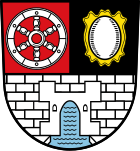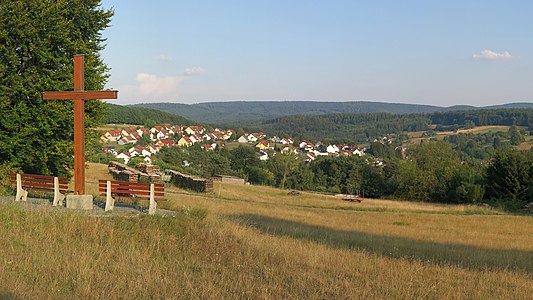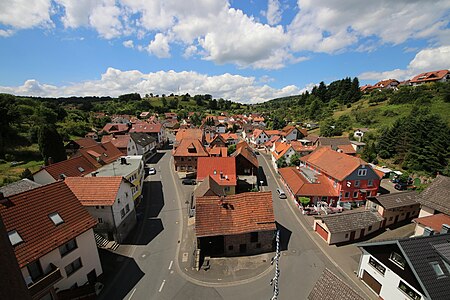Weibersbrunn
| coat of arms | Germany map | |
|---|---|---|

|
Coordinates: 49 ° 56 ' N , 9 ° 22' E |
|
| Basic data | ||
| State : | Bavaria | |
| Administrative region : | Lower Franconia | |
| County : | Aschaffenburg | |
| Height : | 354 m above sea level NHN | |
| Area : | 2.89 km 2 | |
| Residents: | 2001 (Dec. 31, 2019) | |
| Population density : | 693 inhabitants per km 2 | |
| Postal code : | 63879 | |
| Area code : | 06094 | |
| License plate : | AB , ALZ | |
| Community key : | 09 6 71 157 | |
| LOCODE : | DE WB9 | |
| Community structure: | 3 districts | |
| Address of the municipal administration: |
Jakob-Gross-Str. 20 63879 Weibersbrunn |
|
| Website : | ||
| Mayor : | Walter Schreck ( Weibersbrunner List ) | |
| Location of the municipality of Weibersbrunn in the Aschaffenburg district | ||
Weibersbrunn is a municipality in the Lower Franconian district of Aschaffenburg in the middle of the Hoch Spessart .
geography
Geographical location
The community is located in the Bavarian Lower Main region in western Franconia , halfway between Würzburg and Frankfurt am Main . The closest cities are Aschaffenburg and Lohr am Main . The municipality consists of the village of Weibersbrunn and its surroundings and two enclaves in the municipality-free area of Rohrbrunner Forst , each of which has a further district. The topographically highest point of the municipality is 504 m above sea level. NN (location) southeast of Rohrbrunn, on the slopes of the Geiersberg , the lowest east of Weibersbrunn am Steinbach at 303 m above sea level. NN (location) .
View over Weibersbrunn to the southeast to the Geiersberg
Community structure
Weibersbrunn has three districts (the type of settlement in brackets):
- Weibersbrunn ( parish village )
- Echterspfahl ( wasteland )
- Rohrbrunn (village)
The stamp mill to the east is not an official district. There is only the district of Weibersbrunn.
Neighboring communities
|
Waldaschaffer Forest ( non- parish area) |
Rothenbucher Forst (municipality-free area) |
Municipality Rothenbuch |

|
||
|
Rohrbrunner Forst (municipality-free area) |
history
Place name
The name Weibersbrunn goes back to the source of the Weibersbach , where the place was founded. In 1713 the village was entered on maps as am Weibersbron . The Middle High German basic word brunne means source . The meaning of the determiner probably goes back to the name Wibert .
Until the church is planted
The place Weibersbrunn was founded in 1706 as the location of a new operation of the Kurmainzische Spiegelmanufaktur , which already had glassworks in Lohr and Rechtenbach . In 1717 the "Weibersbrunner Spiegelhütte" was built. In 1746 the workers of the hut applied for the construction of their own parish church or at least a chapel.
Weibersbrunn became widely known through the manufacture of baroque goblets and goblets made of glass, and the “ moon glass ”, semi-circular pane glass that was later produced here , made the place internationally famous.
Administrative history
The Electoral Mainz area in the Hochspessart was added to the Principality of Aschaffenburg in 1803 and part of the Grand Duchy of Frankfurt in 1810 . Weibersbrunn was there in 1812 with the glassworks, stone mill and the post, hunter's and forester's houses in the hamlet of Rohrbrunn as a mairie with a total of 96 fireplaces and 459 inhabitants in the area of the Rothenbuch district mairie of the Aschaffenburg department. Maire, Zöllner and Accisor was Georg Adam Rung. His adjuncts were called Balthasar and Jacob Roth. The school teacher was Alois Stahl and the smelter's name was Amrhein. In 1814, Weibersbrunn came to Bavaria with the District Fairie Rothenbuch via Austria , where it was on the territory of the regional court of the older order Rothenbuch. In the course of the administrative reforms in Bavaria, today's municipality was created with the municipal edict of 1818 .
On July 1, 1862, the District Office of Aschaffenburg was formed from the district courts of the older order Rothenbuch and Aschaffenburg , on whose administrative area Weibersbrunn was located. In 1939, as everywhere in the German Reich, the designation district was introduced. Weibersbrunn was now one of the 33 communities in the old district of Aschaffenburg . On July 1, 1972, this merged with the Alzenau district in Lower Franconia to form the new Aschaffenburg district.
20th and 21st centuries
From May 1, 1978 to December 31, 1979, Weibersbrunn belonged to the Waldaschaff administrative community . The other member communities Waldaschaff and Rothenbuch were still connected until December 31, 1993; on January 1, 1994, the administrative community was dissolved.
In 2006 the community celebrated the 300th anniversary with a big festival.
Population development
- 1826: 721 inhabitants
- 1852: 960 inhabitants
- 1859: 817 inhabitants
- 1970: 1817 inhabitants
- 1987: 1934 inhabitants
- 1991: 2060 inhabitants
- 1995: 2137 inhabitants
- 2000: 2146 inhabitants
- 2005: 2109 inhabitants
- 2010: 1994 inhabitants
- 2015: 2041 inhabitants
politics
Municipal council
The council of the municipality of Weibersbrunn consists of 14 council members. This is the fixed number for a municipality with a population between 2001 and 3000. The municipal council is elected for six years. The first mayor is also entitled to vote in the council of the municipality.
The last local election on March 15, 2020 resulted in the following result:
| Political party | Number of seats | change |
|---|---|---|
| CSU | 4th | 0 |
| SPD | 5 | −1 |
| Weibersbrunn list | 5 | +1 |
mayor
The first mayor is Walter Schreck from the Weibersbrunn list . He prevailed in the mayoral election on March 16, 2014 with 615 votes against Guido Noll from the SPD with 538 votes and was elected for a further six years on March 15, 2020 with 63.1% of the votes. Her predecessors from 2002 to 2014 were Herbert Rüppel (SPD) and before that Erich Noll (SPD).
coat of arms
Blazon : Divided; at the top split by red and black, in front a six-spoke silver wheel, behind a silver mirror in a gold frame; below, a bricked silver fountain with an open fountain gate over rippled blue water.
History of the coat of arms: The coat of arms shows the six-spoke silver wheel (Mainzer Rad) of the Archbishopric of Mainz, to which the municipality belonged until the end of the old empire in 1803. A mirror can be seen in the second quarter. It symbolizes the mirror manufactories that were established in the municipality in 1698 in the former glassworks in Rechtenbach and Lohr am Main. Archbishop Lothar Franz von Schönborn had recruited French glassmakers for this. Their factories produced flat glass for mirrors. The glass production was stopped between 1801 and 1803 in Rechtenbach and Lohr am Main, in Weibersbrunn not until 1864. The fountain stands for the local name part “brunn”.
The municipality has had the coat of arms since June 14, 1971.
Architectural monuments
Soil monuments
Economy and Infrastructure
Economy including agriculture and forestry
In 2017 there were 336 jobs subject to social security contributions in the municipality. Of the resident population, 922 people were in employment subject to compulsory insurance. This means that the number of out-commuters was 586 more than that of in-commuters. 40 residents were unemployed. In 2016, the statistics only recorded one farm.
Council taxes
In 2017, the municipal tax revenue amounted to € 1,749 thousand, of which € 401 thousand (net) was trade tax income and € 1,112 thousand was income tax participation.
education
In 2018 there were the following institutions:
- A day-care center with 124 approved places and 97 children, 15 of them under three years of age
- An elementary school with four classes, four teachers and 71 students
traffic
Due to its good transport connections to the Würzburg region and the Rhine / Main area, Weibersbrunn has become an attractive place to live in the inner Spessart ( connection point Weibersbrunn to the federal highway 3 and connection to the federal highway 26 ). State road 2308 runs through the village . The nearest train stations are in Hösbach , Heigenbrücken and Lohr am Main . The next port is the Bayernhafen Aschaffenburg . Local public transport is ensured by a bus line to Aschaffenburg.
Sons and daughters of the church
- Ignaz Roth (1894–1972), German politician (SPD)
literature
- Johann Ludwig Klauprecht: Forest statistics of the Spessarts . Daniel Knode, Aschaffenburg 1826 ( digitized version of the Bavarian State Library )
- Rudolf Virchow : The distress in the Spessart: a medical-geographical-historical sketch; Presented in the Physical-Medicinic Society in Würzburg on March 6th and 13th, 1852 . Separate print from the negotiations of the Physical-Medical Society Third Volume, Stahel'sche Buchhandlung, Würzburg 1852 ( digitized version of the Bavarian State Library )
- Kurt Jeßberger, Manfred Schneider: Rohrbrunn and the Hochspessart: where the oaks protrude defiantly ...; Memories of e. lost wasteland . Self-published, Marktheidenfeld and Kreuzwertheim 1985 (new edition 1987)
- Julia Hecht, Klaus Reder: The district courts of Aschaffenburg and Rothenbuch around 1860: medical officers report . University, Würzburg 2002
Individual evidence
- ↑ "Data 2" sheet, Statistical Report A1200C 202041 Population of the municipalities, districts and administrative districts 1st quarter 2020 (population based on the 2011 census) ( help ).
- ↑ Weibersbrunn. In: Bayerische Landesbibliothek Online. Retrieved November 21, 2019 .
- ^ Wolf-Armin von Reitzenstein : Lexicon of Franconian place names. Origin and meaning . Upper Franconia, Middle Franconia, Lower Franconia. CH Beck, Munich 2009, ISBN 978-3-406-59131-0 , p. 235 ( limited preview in Google Book Search).
- ↑ Art. 41 of the law on the change in the membership of municipalities in administrative communities of 10 August 1979 ( GVBl p. 223)
- ↑ Municipal Code for the Free State of Bavaria (Municipal Code - GO) in the version published on August 22, 1998; Art. 31 - Composition of the municipal council , accessed on November 21, 2019
- ^ Result of the election of the municipal council on March 15 , 2020, accessed on June 20, 2020
Web links
- Entry on the coat of arms of Weibersbrunn in the database of the House of Bavarian History






